
Peter Robert Berry II
Das Werk
Die bildende Kunst nahm in Peter Robert Berrys Leben seit seiner Kindheit eine wichtige Stellung ein. Aber erst eine tiefe Lebenskrise, bedingt durch den Bruch mit seiner amerikanischen Verlobten, liess den nun schon Mitte dreissig Jahre alten Berry zur Malerei finden. Seine Bekanntschaft mit Giovanni Giacometti und auch Giovanni Segantini, den er kurz vor seinem Tod 1899 noch persönlich traf, bestärkte den Wunsch, professionell und in Öl zu malen.
Bereits in diesem Jahr begann er sein erstes grossformatiges Ölbild, «Weihnachtsabend» (1899 – 1901), während er renommierte Kunstschulen in Paris und München besuchte. Sein Vorbild blieb dabei Segantini und insbesondere dessen divisionistischer Stil: Farben werden nebeneinander in feinen Strichen ungemischt aufgetragen. Erst im Auge des Betrachters entsteht später eine Synthese aus Farben, Licht und Schatten. Diese Technik überzeugt insbesondere angesichts der feinsten Farbmuster und Schattierungen, die die schneebedeckte Engadiner Bergwelt evoziert. Bei Berry wirkt sie plastisch und bewegt.

Malen in freier Natur
Peter Robert Berry verstand sich insbesondere als Maler des Julier- und Berninapasses. Mit diesen ausgezeichneten Punkten der Engadiner Landschaft sind seine kraftvollsten Bilder verknüpft.
Die Präsenz dieser Werke verdankt sich der unermüdlichen Suche nach dem weiten Horizont, der Klarheit der Umrisse und den intensiven Lichtstimmungen auf über 2000 Meter über Meer. Berry malte seine Bergbilder wie schon Segantini in freier Natur. Eine grosse Holzkiste barg die Leinwand, ein Bretterverschlag schützte notdürftig gegen den Wind, Stiefel, Gamaschen, Mantel und Hut mussten bei Schnee und Kälte genügen.
Leidenschaft für Pferde
Eine besondere Leidenschaft von Peter Robert Berry II galt den Pferden. Immer wieder begegnen sie uns in seinem Werk: Auf Zeichnungen und Skizzen oder auf Ölgemälden. Dabei ist erstaunlich, wie sich ihre Statur und ihre Physiognomie abbilden. Die Dynamik scheint manchmal den selbstgesetzen Rahmen der Zeichnung zu sprengen.
Pferde tauchen bei Berry sowohl als stolze Zugpferde der Bernina- oder Julierpost auf oder als reich geschmückte Teilnehmer einer «Schlitteda», dann wieder als Athleten im Pferderennen und Skijöring oder auch als abgehärtete Kreaturen, der gewaltigen Natur ausgesetzt. Seine Pferdeallegorien zum Jugendfrühling, zu den Titanenkämpfen und das Mann-Pferd-Phänomen erinnern unter anderem an Arnold Böcklins Zentauren und Giorgio de Chiricos metaphysischen Surrealismus.
Jahreszeiten
Schnee ist das zentrale Element in Peter Robert Berrys Bildern. Man könnte meinen, seine Bilder wollten der Engadiner Redeweise «neun Monate Winter und drei Monate kalt» gerecht werden. Selbst wenn er das Engadin im Frühling, Sommer und Herbst malt, bilden poröse Schneereste oder vorzeitig gefallenes luftiges Weiss reizvolle Kontraste zu sattem Grün und Gelb.
Die Palette kräftigster Farben zeigt hingegen das Gemälde «Sommerabend am St. Moritzer See», 1922. Hier leuchten die Bergspitzen und die sanften Grashänge darunter über den dunklen Hügeln des Stazer Walds, darunter fängt der See das Licht in der Spiegelung wieder auf. Eine spannende, kontrapunktische Komposition.
Reine Abstraktion
Ist der Stil bei Peter Robert Berry anfänglich klassisch divisionistisch im Stile Giovanni Seganinis, finden sich später auch abstrakte Skizzen und sogar Ölbilder.
In dem Bild «Einzug der Nationen, Winterolympiade St. Moritz» von 1928 lösen sich die Sportler und Zuschauer, die Aufbauten und die Fahnen zu Farbimpressionen im verschneiten Olympia-Stadion im Kulmpark. Dabei vermittelt das Bild einen klaren Eindruck der Bewegungen und der Aufstellung der Menschen während eines historischen Moments.
Gallery


















